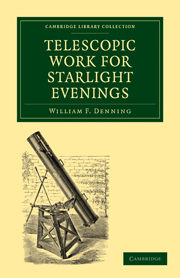Book contents
- Frontmatter
- PREFACE
- Contents
- ILLUSTRATIONS
- CHAPTER I THE TELESCOPE, ITS INVENTION AND THE DEVELOPMENT OF ITS POWERS
- CHAPTER II RELATIVE MERITS OF LARGE AND SMALL TELESCOPES
- CHAPTER III NOTES ON TELESCOPES AND THEIR ACCESSORIES
- CHAPTER IV NOTES ON TELESCOPIC WORK
- CHAPTER V THE SUN
- CHAPTER VI THE MOON
- CHAPTER VII MERCURY
- CHAPTER VIII VENUS
- CHAPTER IX MARS
- CHAPTER X THE PLANETOIDS
- CHAPTER XI JUPITER
- CHAPTER XII SATURN
- CHAPTER XIII URANUS AND NEPTUNE
- CHAPTER XIV COMETS AND COMET-SEEKING
- CHAPTER XV METEORS AND METEORIC OBSERVATIONS
- CHAPTER XVI THE STARS
- CHAPTER XVII NEBULÆ AND CLUSTERS OF STARS
- NOTES AND ADDITIONS
- INDEX
- Plate section
CHAPTER II - RELATIVE MERITS OF LARGE AND SMALL TELESCOPES
Published online by Cambridge University Press: 05 July 2011
- Frontmatter
- PREFACE
- Contents
- ILLUSTRATIONS
- CHAPTER I THE TELESCOPE, ITS INVENTION AND THE DEVELOPMENT OF ITS POWERS
- CHAPTER II RELATIVE MERITS OF LARGE AND SMALL TELESCOPES
- CHAPTER III NOTES ON TELESCOPES AND THEIR ACCESSORIES
- CHAPTER IV NOTES ON TELESCOPIC WORK
- CHAPTER V THE SUN
- CHAPTER VI THE MOON
- CHAPTER VII MERCURY
- CHAPTER VIII VENUS
- CHAPTER IX MARS
- CHAPTER X THE PLANETOIDS
- CHAPTER XI JUPITER
- CHAPTER XII SATURN
- CHAPTER XIII URANUS AND NEPTUNE
- CHAPTER XIV COMETS AND COMET-SEEKING
- CHAPTER XV METEORS AND METEORIC OBSERVATIONS
- CHAPTER XVI THE STARS
- CHAPTER XVII NEBULÆ AND CLUSTERS OF STARS
- NOTES AND ADDITIONS
- INDEX
- Plate section
Summary
The number of large telescopes having so greatly increased in recent years, and there being every prospect that the demand for such instruments will continue, it may be well to consider their advantages as compared with those of much inferior size. Object-glasses and specula will probably soon be made of a diameter not hitherto attained; for it is palpably one of the ambitions of the age to surpass all previous efforts in the way of telescopic construction. There are some who doubt that such enormous instruments are really necessary, and question whether the results obtained with them are sufficient return for the great expense involved in their erection. Large instruments require large observatories; and the latter must be at some distance from a town, and in a locality where the atmosphere is favourable. Nothing can be done with great aperture in the presence of smoke and other vapours, which, as they cross the field, become ruinous to definition. Moreover, a big instrument is not to be manipulated with the same facility as a small one: and when anything goes wrong with it, its rectification may be a serious matter, owing to the size. Such telescopes need constant attention if they would be kept in thorough working order. On the other hand, small instruments involve little outlay, they are very portable, and require little space. They may be employed in or out of doors, according to the inclination and convenience of the observer.
- Type
- Chapter
- Information
- Telescopic Work for Starlight Evenings , pp. 20 - 37Publisher: Cambridge University PressPrint publication year: 2010First published in: 1891



